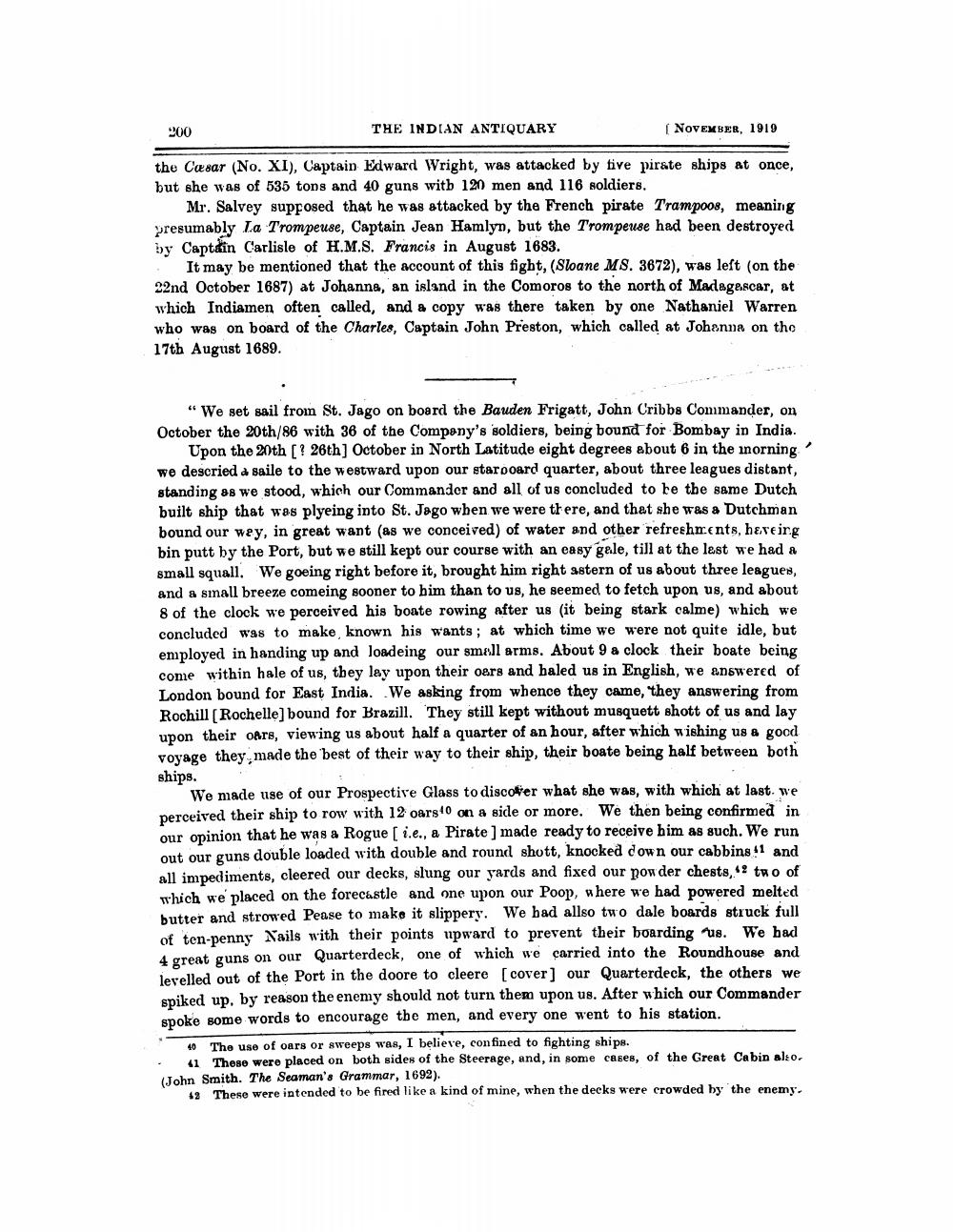________________
200
THE INDIAN ANTIQUARY
( NOVEMBER, 1919
the Cæsar (No. XI), Captain Edward Wright, was attacked by five pirate ships at once, but she was of 535 tons and 40 guns with 120 men and 116 soldiers.
Mr. Salvey supposed that he was attacked by the French pirate Trampoos, meaning presumably La Trompeuse, Captain Jean Hamlyn, but the Trompeuse had been destroyed by Captain Carlisle of H.M.S. Francis in August 1683.
It may be mentioned that the account of this fight, (Sloane MS. 3672), was left (on the 22nd October 1687) at Johanna, an island in the Comoros to the north of Madagascar, at which Indiamen often called, and a copy was there taken by one Nathaniel Warren who was on board of the Charles, Captain John Preston, which called at Johanna on the 17th August 1689.
“We set sail from St. Jago on board the Bauden Frigatt, John Cribbs Commander, on October the 20th/86 with 36 of the Company's soldiers, being bound for Bombay in India.
Upon the 20th [? 26th] October in North Latitude eight degrees about 6 in the inorning we descried a saile to the westward upon our starpoard quarter, about three leagues distant, standing 88 we stood, which our Commander and all of us concluded to be the same Dutch built ship that was plyeing into St. Jago when we were there, and that she was a Dutchman bound our wey, in great want (as we conceived) of water and other refreshments, hexe irg bin putt by the Port, but we still kept our course with an easy gale, till at the last we had a small squall. We goeing right before it, brought him right astern of us about three leagues, and a small breeze comeing sooner to him than to us, he seemed to fetch upon us, and about 8 of the clock we perceived his boate rowing after us it being stark calme) which we concluded was to make known his wants; at which time we were not quite idle, but employed in handing up and loadeing our small arms. About 9 a clock their boate being come within hale of us, they lay upon their oers and haled us in English, we answered of London bound for East India. We asking from whence they came, they answering from Rochill (Rochelle) bound for Brazill. They still kept without musquett shott of us and lay upon their oars, viewing us about half a quarter of an hour, after which wishing us a good voyage they made the best of their way to their ship, their boate being half between both ships.
We made use of our Prospective Glass to discoter what she was, with which at last we perceived their ship to row with 12 oars10 on a side or more. We then being confirmed in our opinion that he was a Rogue [i.e., a Pirate ] made ready to receive him as such. We run out our guns double loaded with double and round shott, knocked down our cabbins 11 and all impediments, cleered our decks, slung our yards and fixed our powder chests, two of which we placed on the forecastle and one upon our Poop, where we had powered melted butter and strowed Pease to make it slippery. We had allso two dale boards struck full of ten-penny Nails with their points upward to prevent their boarding us. We had 4 great guns on our Quarterdeck, one of which we carried into the Roundhouse and levelled out of the Port in the doore to cleere [cover] our Quarterdeck, the others we spiked up, by reason the enemy should not turn them upon us. After which our Commander spoke some words to encourage the men, and every one went to his station.
40 The use of oars or sweeps was, I believe, confined to fighting ships.
41 These were placed on both sides of the Steerage, and, in some cases, of the Great Cabin also. (John Smith. The Seaman's Grammar, 1692).
12 These were intended to be fired like a kind of mine, when the decks were crowded by the enemy.




